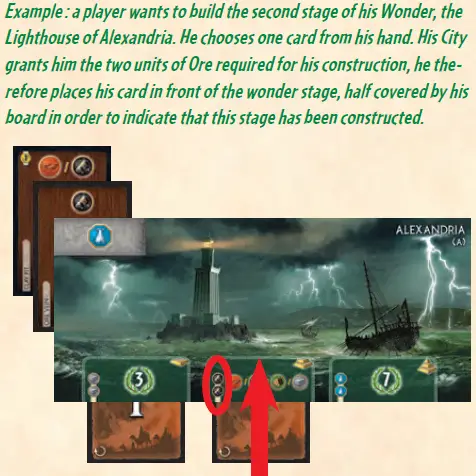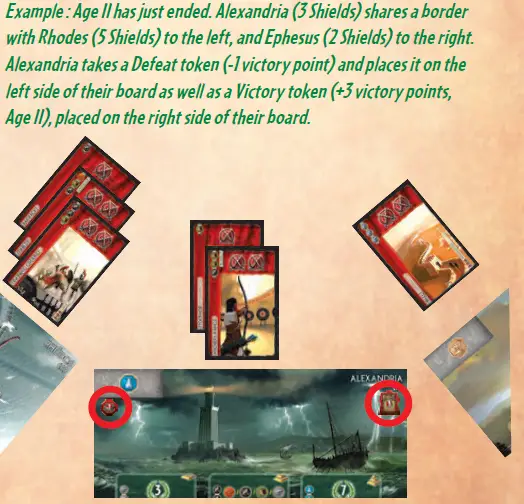How to Play 7 Wonders if you hate rulebooks
Condensed how to play 7 Wonders Rules to help you skip the rulebook and get started quick.
This section focuses on 7 Wonders gameplay. Click here for details on how to setup the game.
What is the goal?
- Lead one of the 7 great cities of the Ancient World.
- Player Count: 2-7 players.
- Gameplay:
- Card Drafting: Build cities over multiple rounds.
- Development: Establish commercial routes, grow military, erect architectural wonders.
- Scoring:
- Points: Based on collected cards and military battles.
- Winner: Player with the most points.
7 Wonders Gameplay Overview
- Game spans across 3 Ages
- One deck per Age
- Gameplay:
- Card Play: Develop city and build Wonder.
- End of each Age players compare military strength with neighboring cities (players to right and left).
- Game ends after the 3rd Age. Player with the most victory points wins.
Construction in 7 Wonders
Building Structures and Wonders:
- Structures (cards) and Wonders (board) built in all 3 Ages.
- Structures: Free, coin cost, or resource cost.
- Wonders: Always have a resource cost.
Coin Cost:
- Some brown cards require a coin, paid on the construction turn.
Free Construction:
- Some cards have no cost, can be played for free.
Resource Cost:
- Some cards require resources.
- Resources can be produced by the player or bought from neighboring cities.
Production:
- Wonder board, brown cards, gray cards, and some yellow cards produce city resources.
- To build a structure, the city must produce the resources indicated on the card.

Commerce
Purchasing Resources:
- Players can buy resources from their neighboring cities (left or right player) if they produce them.
- Resources available for purchase:
- Those initially produced by the city (as indicated on the board).
- Raw materials from brown cards.
- Manufactured goods from gray cards.
- Resources from commercial structures (yellow cards) or Wonders cannot be purchased; they are reserved for the owner.
- Each purchased resource costs 2 coins.
Clarifications:
- Selling a resource to a neighboring city does not prevent the seller from using it in the same turn.
- Players can buy multiple resources from both neighboring cities.
- Purchased resources can only be used in the turn they are bought.
- Players cannot refuse to sell resources.
- Some commercial structures (yellow cards) reduce the cost of buying resources from 2 coins to 1 coin.
- If both neighboring cities produce a desired resource, the player can buy from either.
- Coins earned through commerce during a turn cannot be used in that turn; they can only be used in the next turn.
Free Construction (Chains)
- Some Age II and Age III structures have the name of a previous age structure listed next to their resource cost.
- Players can build these structures for free if they have previously built the specified structure from the earlier age.

Step by Step How to play 7 Wonders
Gameplay Overview
- The game is played over 3 Ages.
- At the start of each Age, each player receives 7 cards from that Age’s deck, dealt randomly.
- Each Age consists of 6 game turns.
Turn Structure:
- Choose a Card:
- Each player selects one card from their hand.
- Action:
- Players simultaneously put the chosen card into play.
- Move on to Next Hand:
- Players pass their remaining cards to the next player and repeat the process for the next turn.
Choose a Card
- Each player looks at their hand, keeping it hidden from others, and selects a card.
- The chosen card is placed face down in front of the player.
- The remaining cards are placed between the player and their left-hand neighbor.
Action
Once all players have selected their cards, they simultaneously perform one of the following actions with their chosen card:
- Build the Structure: Use the card to construct a building.
- Build a Stage of Wonder: Use the card to advance the construction of their Wonder.
- Discard the Card to Gain Coins: Discard the card to receive coin
Build the Structure

- The structure represented by the selected card is built.
- Brown and gray cards are placed beneath one another, starting from the upper left corner of the Wonders board.
- Other cards are placed face up in the area in front of the Wonder board.
Build a Stage of Wonder

- Pay the price shown on the Wonder board.
- Use the card as a construction marker by playing it face down, half hidden under the Wonder board.
- Stages of a Wonder must be built in order, from left to right, and Wonder construction is not mandatory.
- The card used to mark the construction of a Wonder stage remains hidden and has no effects.
Discard the Card to Gain Coins
- Discard the card to take 3 coins from the bank.
- The discarded card remains face down in the discard pile in the center.
- If the chosen card does not allow building either the structure or Wonder stage, discard the card and take 3 coins.
Move on to Next Hand
- Take the hand of cards from the neighbor.
- The direction of hand rotation changes with each Age:
- Age I: Cards are passed to the left.
- Age II: Cards are passed to the right.
- Age III: Cards are passed to the left.
- Special Case: Sixth Turn:
- At the beginning of the final turn (6th) of each Age, receive a two-card hand from the neighbor.
- Choose one card to play and discard the other face down.
- The selected card is played normally, and the Age ends.
- The discarded card does not earn 3 coins.
End of an Age

- Players resolve military conflicts at the end of each Age (6th turn).
- Compare the total shields on military structures (red cards) with the total of each neighboring city:
- Higher total: Take a Victory token corresponding to the Age just played.
- Age I: +1
- Age II: +3
- Age III: +5
- Lower total: Take a Defeat token (-1 Victory Point).
- Equal total: No token is taken.
- Higher total: Take a Victory token corresponding to the Age just played.
End of Game and Winning
- The game ends at the end of the third Age, after Conflict tokens are handed out.
- Each player counts their victory points.
- The player with the highest total wins.
- In case of a tie, the player with the most coins in their treasure wins.
- A tie on coins is not broken further.
Counting Victory Points
Count points in this order.
1. Military Conflicts
Each player adds their Victory & Defeat tokens (this total can be negative).
2. Treasury Contents
For every 3 coins in their possession at the end of the game, players score 1 victory point. Any leftover coins score no points.
3. Wonders
Each player then adds to their score the victory points of their wonder.
4. Civilian Structures
Each player adds the victory points of their Civilian structures and this amount is indicated on each Civilian structure.
5. Scientific Structures
The scientific cards earn victory points in two very different ways:
– from sets of identical symbols
– from sets of 3 different symbols
Be careful: the victory points earned by both methods are cumulative.
Sets of identical symbols
For each of the 3 existing scientific symbols, the player wins the following points:
- Only 1 symbol: 1 victory point
- 2 identical symbols: 4 victory points
- 3 identical symbols: 9 victory points
- 4 identical symbols: 16 victory points
Note:- the number of points gained is equal to the number of symbols squared- there are 4 green cards fo=r each symbol, for a maximum of 16 victory points per family of symbols- this maximum can increase with the Scientific Guild and Wonder of Babylon: 5 identical symbols = 25 victory points & 6 identical symbols = 36 victory points.
Sets of 3 different symbols
For each of the 3 different symbols, each player scores 7 victory points.
6. Commercial Structures
Some commercial structures from Age III grant victory points.
7. Guilds
Each guild is worth a number of victory points. This depends on the configuration of the player’s city and/or that of the two neighbouring cities.